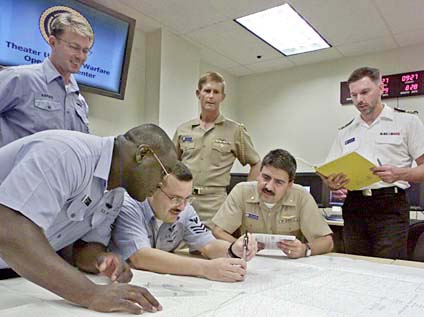
DEAN SENSUI / DSENSUI@STARBULLETIN.COM
Chief Petty Officer-select Renard Goods, left, and Petty Officers 1st Class Bill Harris and Bruce Miranda join Capt. Robert Ford, Lt. Cmdr. Moe Vargas and Canadian navy Lt. Cmdr. Derek McCliggett in the new submarine command center at Pearl Harbor. Ford says diesel subs' ability to remain quiet and nearly undetectable pose a problem for the U.S. Navy.
Diesel subs surface
as a new threatThe Navy is testing several
new detection systems, including
one developed in the isles
Highly capable diesel-powered submarines have emerged as the U.S.'s "premier potential adversary" since the end of the Cold War.
In recent years, China, North Korea and other countries have acquired diesel-electric submarines that are so quiet in the water that it is difficult for U.S. forces to detect and track them. "We have to be able to deal with that," said Adm. Walter Doran, Pacific Fleet commander, this week.
Last month Australia newspapers reported that the HMAS Waller, a diesel submarine, was invisible to an American nuclear sub during undersea war games. An unidentified U.S. sub was "sunk" by practice torpedoes fired by the Waller during the exercise.
At Pearl Harbor, Capt. Robert Ford, the Pacific Fleet Submarine Force's chief of staff, said the majority of the 380 submarines populating the seas are diesel powered. The U.S. Navy has no diesel submarines. Its 80 nuclear attack and ballistic missile submarines are split between the Pacific and Atlantic theaters.
"Diesel submarines pose a real problem," added Ford, who directs the area's anti-submarine warfare programs. "It's a formidable threat when you think what a diesel-powered submarine can do. They're very quiet when running on batteries and they can remain submerged for extended periods of time, from days to weeks. With the advent of air independent propulsion, the need to come up and recharge their batteries is drastically reduced."
Besides their ability to remain quiet and nearly undetectable, Ford said, some of these diesel subs are outfitted to remain on the ocean bottom, motionless for extended periods of time.
"They have mining capability, some of them have cruise missiles. They are a very difficult threat, something we haven't faced."
"Diesel submarines only make a sound when they come up to snorkel to recharge their batteries," Ford added. "That's the problem -- all the sensing devices are predicated on the passive acoustical spectrum."
Doran this week told reporters in Washington that when the Cold War ended the Navy let its anti-submarine warfare capabilities erode, since there no longer was a threat from the Soviet Union's ballistic missile long- range nuclear submarines.
Following the fall of the Berlin Wall, many Third World nations started pursuing the latest designs in diesel submarine technology. Advances in battery technology and alternate energy producing systems allowed diesel subs to submerge longer operating on batteries. There were new designs and materials to quiet noisy submarine sources as well as defeat active sonar systems. The diesel subs also operate in the much noisier and difficult shallow waters near shore. These modernized diesel submarines can be used to insert military personnel, lay deadly minefields, launch devastating cruise and guided missile, threaten vital shipping lanes, and of course, attack ships and submarines.
To meet the diesel threat, the U.S. Navy have been testing detection devices that don't rely on sonar and other methods to hear the location of enemy submarines.
Among those systems under consideration is one being developed and tested by Science & Technology International -- a Honolulu-based firm -- called Littoral Airborne Sensor Hyperspectral. In the past, STI has used hyperspectral imaging to create maps of coral reefs at ocean depths of up to 100 feet. The process uses a $1 million camera to shoot the specialized photos that provide highly detailed color images of the sea floor.
The LASH system uses digital cameras, which are mounted in SH-60 Seahawk helicopters or pods attached to P-3 Orion subhunter aircraft, and computers to try to locate submarines. The company has a $4 million contract with the Navy to test the system.
The light the digital camera sees is split into 288 wavelengths, including ultraviolet and infrared light, and fed into a computer which translates them into patterns and shapes. Just how far the LASH system can reach into the sea is classified.
One of the "significant" drawbacks of LASH, Ford said, is that it can only work in the day.
However, Ford points out that LASH is "just one of the many competing technologies. He believes that the Navy's antisubmarine warfare program will be centered around more than one system.
